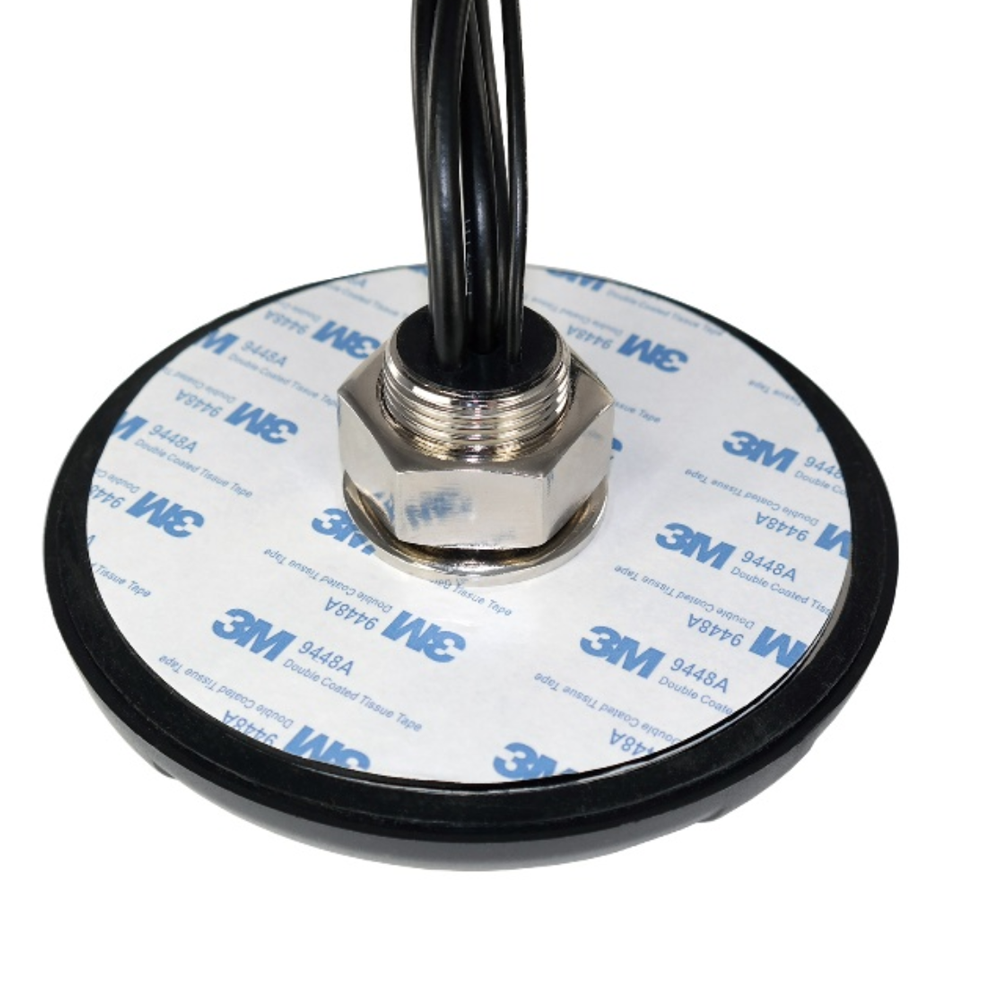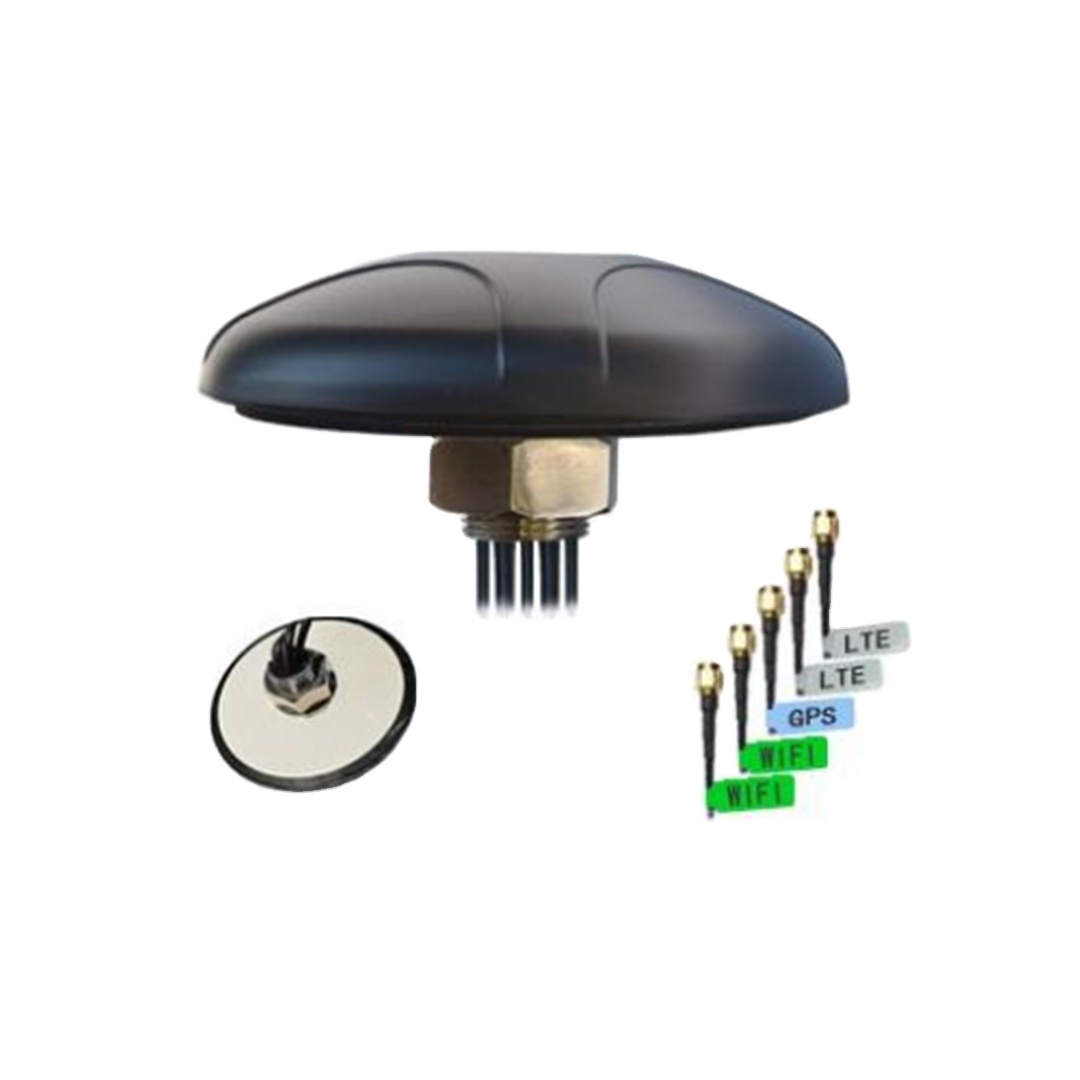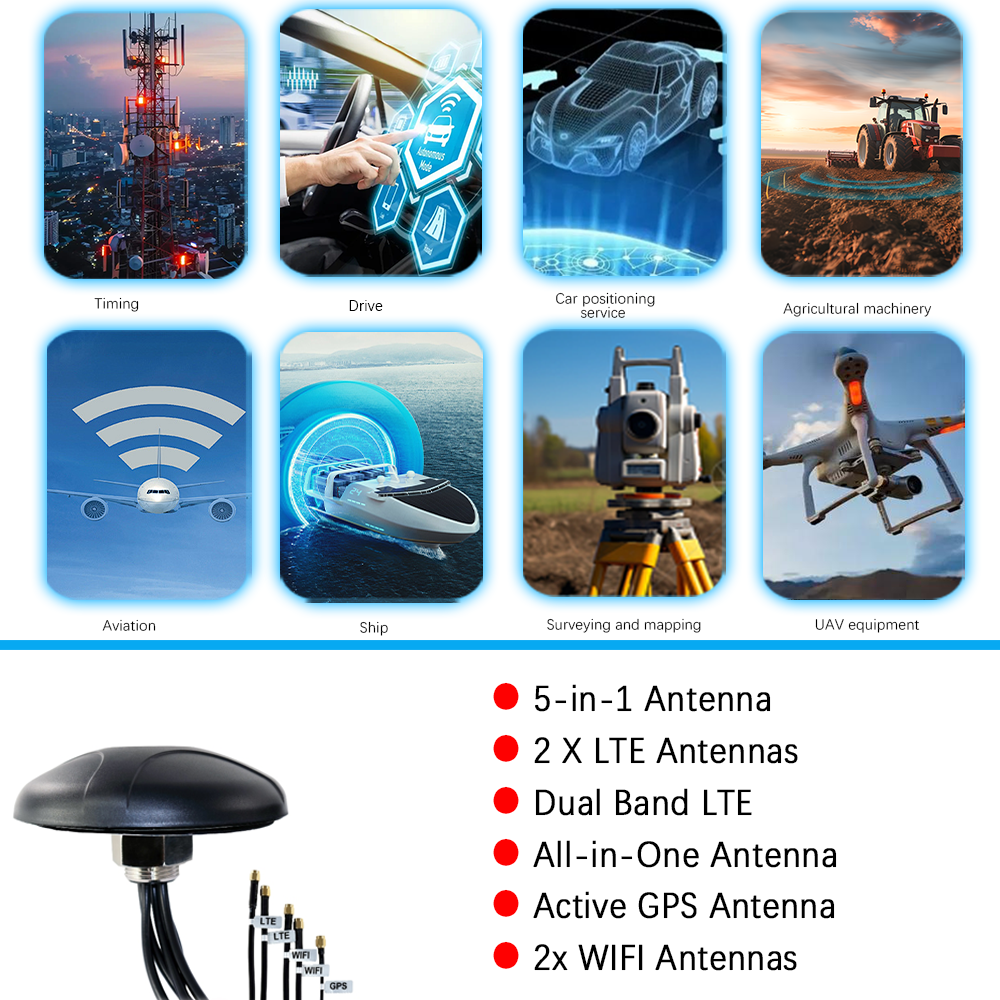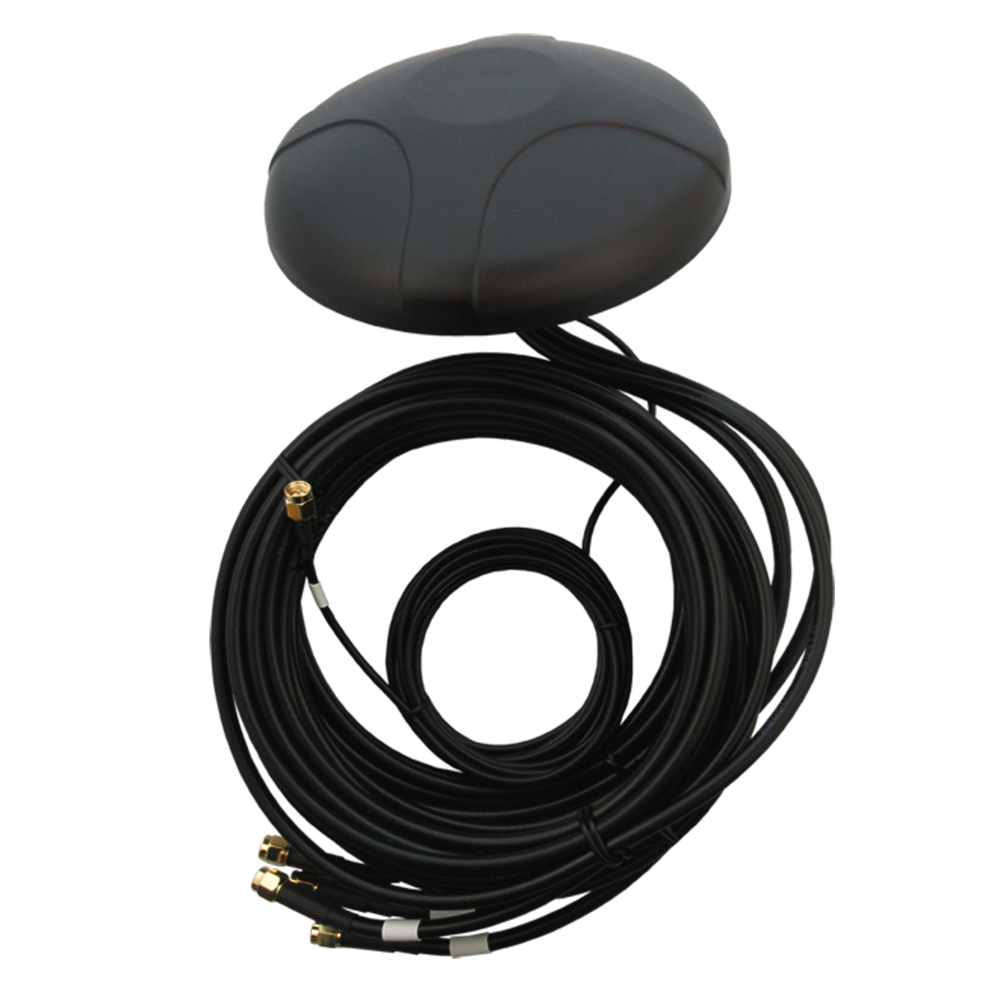The term “mushroom” in the antenna’
The term “mushroom” in the antenna’s name refers to its physical design: a compact, rounded top (resembling a mushroom cap) mounted on a short base (the stalk). This shape is not merely aesthetic but serves critical functional purposes. The rounded top minimizes wind resistance and aerodynamic drag, making it ideal for vehicle mounting—whether on car roofs, truck cabins, or marine vessels—where sleek design and reduced air resistance are essential. The short base ensures stability, even at high speeds, preventing vibrations or dislodgment during movement. Additionally, the compact size of the mushroom design allows for flexible installation in space-constrained environments, such as dashboard corners, vehicle pillars, or the hulls of boats, without compromising signal reception.
At the core of the mushroom GPS antenna’s performance is its support for multiple satellite constellations, including GLONASS and BDS (BeiDou), alongside GPS. This multi-constellation compatibility is a key advantage, as it leverages signals from a larger number of satellites, enhancing positioning accuracy and reliability. GLONASS, Russia’s global navigation system, operates in the 1602–1615.5 MHz frequency range, while BDS (BeiDou) covers bands such as B1 (1561.098 MHz), B2 (1207.14 MHz), and B3 (1268.52 MHz). GPS, the U.S. constellation, uses L1 (1575.42 MHz) as its primary band. By supporting these frequencies—1575 MHz (GPS), 1561 MHz (BDS B1), and others—the mushroom antenna ensures seamless navigation across global regions, from urban centers to remote wilderness areas, where satellite visibility may be limited. This multi-constellation support is particularly valuable in environments with signal blockages, such as urban canyons or dense forests, as it reduces the risk of positioning errors caused by lost satellite signals.
Beyond satellite navigation, the mushroom GPS antenna integrates 24G and 2WIFI MIMO (Multiple-Input Multiple-Output) capabilities, making it a true multi-functional communication hub. 4G LTE operates across two frequency ranges: 824~960 MHz (low band) and 1710~2690 MHz (mid to high band). The low band offers superior penetration through obstacles like buildings and foliage, ensuring reliable connectivity in rural or urban areas with weak cellular signals. The mid to high band, on the other hand, supports higher data transfer rates, enabling applications such as real-time video streaming, over-the-air (OTA) updates, and high-speed internet access in vehicles. The 2*4G MIMO configuration uses two antennas to transmit and receive data simultaneously, reducing signal interference and improving connection stability—a critical feature for in-vehicle communication systems that rely on consistent 4G links for telematics, emergency services, and fleet management.
For WIFI connectivity, the antenna operates in the 2400~2500 MHz band, a globally accepted frequency range for WIFI 4 (802.11n) and earlier standards. The 2*WIFI MIMO setup enhances wireless performance by using two antennas to increase data throughput and extend coverage. This is particularly useful for in-vehicle infotainment systems, allowing passengers to connect their smartphones, tablets, or laptops to a local WIFI network, stream media, or access cloud services. In addition, WIFI connectivity supports device-to-device communication, enabling features like wireless mirroring of smartphone screens to vehicle displays or seamless integration with IoT sensors in smart vehicles.
gain specification of 28 dBi
The gain specification of 28 dBi is a standout feature of the mushroom GPS antenna, underscoring its ability to amplify weak signals significantly. Gain, measured in decibels relative to an isotropic radiator (dBi), quantifies the antenna’s ability to focus signal energy in specific directions. A high gain of 28 dBi is particularly valuable for satellite navigation, where signals from space are inherently weak after traveling thousands of kilometers. This amplification ensures that even faint signals from GLONASS, BDS, or GPS satellites are captured and processed accurately, resulting in precise positioning data—essential for applications like autonomous driving, where centimeter-level accuracy is required. For 4G and WIFI, the high gain extends the range of cellular towers and wireless routers, ensuring connectivity in remote areas or locations with limited infrastructure.
The VSWR (Voltage Standing Wave Ratio) of 2.0 is a critical indicator of the antenna’s efficiency in power transfer. VSWR measures the ratio of maximum to minimum voltage in a standing wave pattern along a transmission line, with a value of 1 indicating perfect matching (no signal reflection). A VSWR of 2.0 means that only about 10% of the signal is reflected back to the source, with 90% being transmitted or received. This high efficiency is essential for maintaining signal integrity, especially in multi-band antennas where interference between frequencies could degrade performance. The mushroom design helps minimize VSWR by optimizing the antenna’s internal structure, ensuring that each frequency band (GNSS, 4G, WIFI) operates with minimal reflection, even when used simultaneously.
The connector options—SMA, FAKRA, MCX— enhance the antenna’s versatility and compatibility with diverse devices. SMA connectors are widely used in industrial and consumer electronics, offering a robust, threaded design that ensures secure connections in high-vibration environments like vehicles. FAKRA connectors, on the other hand, are standard in automotive applications, featuring color-coding to prevent incorrect connections between different signal types (e.g., GPS, 4G, WIFI). This is particularly valuable in vehicle manufacturing, where multiple antennas and cables must be installed quickly and accurately. MCX connectors are smaller and lighter, making them ideal for compact devices or applications where space is at a premium, such as portable navigation systems or IoT sensors. The availability of multiple connector types ensures that the mushroom GPS antenna can be integrated into virtually any hardware configuration, from large trucks to small drones.
The cable specifications—300 mm length with RG174 cable— are tailored to balance flexibility, signal integrity, and installation convenience. RG174 is a lightweight, low-loss coaxial cable commonly used in RF applications, offering good shielding against electromagnetic interference (EMI) and radio frequency interference (RFI). This shielding is critical in vehicles, where electrical systems (e.g., engines, alternators) generate significant EMI that could disrupt satellite or cellular signals. The 300 mm length provides enough flexibility to route the cable from the antenna’s mounting point (e.g., roof) to the receiver (e.g., dashboard) without excess slack, reducing the risk of tangling or interference. For applications requiring longer cable runs, RG174 can be extended with compatible connectors, though signal loss may increase—making it important to balance cable length with performance requirements.
The material—ABS (Acrylonitrile Butadiene Styrene)— contributes significantly to the antenna’s durability and performance. ABS is a thermoplastic polymer known for its high impact resistance, chemical stability, and resistance to UV radiation. These properties make it ideal for outdoor applications, where the antenna is exposed to harsh weather conditions—rain, snow, extreme temperatures, and sunlight. The mushroom-shaped housing, made from ABS, protects the internal components (e.g., ceramic resonators, amplifiers, filters) from physical damage, ensuring long-term reliability. Additionally, ABS is easy to mold into complex shapes, allowing manufacturers to optimize the antenna’s form for both aerodynamics and signal reception. The black color of the antenna not only provides a sleek, unobtrusive appearance on vehicles but also helps absorb heat, preventing overheating in direct sunlight—a critical factor for maintaining performance in high-temperature environments.
Polarization is another key feature, with the antenna supporting both RHCP (Right-Hand Circular Polarization) and linear polarization. GNSS satellites transmit signals using RHCP, which minimizes signal loss caused by atmospheric effects, reflections, and Faraday rotation. By matching this polarization, the mushroom GPS antenna ensures maximum signal absorption for satellite navigation, reducing errors caused by polarization mismatch. For 4G and WIFI, linear polarization is used, aligning with the vertical or horizontal polarization of cellular towers and wireless routers. This dual polarization support allows the antenna to optimize performance across different frequency bands, ensuring reliable connectivity for both navigation and communication.
The circular polarization specified for the antenna further enhances its satellite navigation capabilities. Circular polarization ensures that the antenna can receive signals from satellites regardless of their orientation relative to the Earth’s surface. This is particularly valuable in dynamic environments, such as moving vehicles or marine vessels, where the antenna’s orientation changes constantly. Unlike linear polarization, which is sensitive to angle, circular polarization maintains signal strength even when the antenna is tilted or rotated, ensuring consistent positioning data during acceleration, braking, or turns.
applications
In terms of applications, the mushroom GPS antenna is highly versatile, with particular strengths in automotive and transportation sectors. In passenger vehicles, it serves as the backbone of infotainment and navigation systems, providing real-time GPS/GLONASS/BDS positioning for turn-by-turn directions, 4G connectivity for traffic updates and OTA software updates, and WIFI for in-car hotspots. The compact mushroom design integrates seamlessly with modern vehicle aesthetics, avoiding the bulk of traditional whip antennas. For commercial trucks and fleet vehicles, the antenna enables precise tracking via multi-constellation GNSS, ensuring fleet managers can monitor vehicle locations, optimize routes, and improve fuel efficiency. The 4G MIMO capability supports two-way communication, allowing dispatchers to send instructions to drivers and receive real-time data on vehicle performance.
Marine applications also benefit from the mushroom GPS antenna’s robust design. Mounted on boats, yachts, or commercial vessels, it provides reliable GNSS positioning for navigation in coastal or open waters, where satellite visibility can be affected by waves or hull obstructions. The ABS housing resists corrosion from saltwater, ensuring durability in marine environments. 4G connectivity enables communication with shore-based facilities, while WIFI supports on-board networks for crew communication and entertainment.
In agriculture, the antenna is integrated into precision farming equipment, such as GPS-guided tractors and harvesters. Its multi-constellation support ensures accurate positioning in rural areas, where satellite coverage may be sparse, enabling precise seeding, fertilization, and harvesting. The 4G link allows farmers to upload data to cloud platforms for analysis, optimizing crop yields and reducing resource waste.
IoT devices deployed in remote locations, such as environmental monitors or wildlife trackers, rely on the mushroom GPS antenna for compact, reliable connectivity. Its small size and low power consumption make it suitable for battery-powered devices, while the high gain ensures that even in remote areas, satellite signals are captured and 4G/WIFI connections are maintained. This enables real-time data transmission for applications like weather monitoring, wildfire detection, and asset tracking.
Despite its many advantages, the mushroom GPS antenna has considerations. Its high gain, while beneficial for signal strength, can make it more directional than omnidirectional antennas, requiring careful mounting to ensure a clear view of the sky for GNSS reception. Manufacturers typically recommend mounting the antenna on a flat, elevated surface (e.g., vehicle roof) with unobstructed visibility to maximize satellite contact. Additionally, the 300 mm cable length may be insufficient for some installations, requiring extensions that could introduce signal loss—though high-quality RG174 extensions can mitigate this issue.
In conclusion
-
In conclusion, the mushroom GPS antenna—officially designated as the GLONASS BDS Antenna—represents a fusion of innovative design and advanced technology, offering multi-constellation navigation, high-speed 4G communication, and reliable WIFI connectivity in a compact, durable package. Its mushroom-shaped form balances aerodynamics, stability, and signal performance, making it ideal for vehicle-mounted and outdoor applications. With support for GLONASS, BDS, GPS, 4G MIMO, and WIFI MIMO, it meets the diverse needs of modern connectivity, from precise navigation to seamless data transmission. As the demand for connected mobility and IoT expands, the mushroom GPS antenna will continue to play a pivotal role, enabling reliable, efficient, and versatile communication in an increasingly interconnected world. Its combination of performance, durability, and flexibility ensures that it remains a top choice for engineers, manufacturers, and users across industries.




































































 Language
Language
 En
En Cn
Cn Korean
Korean

 Home >
Home > 








 18665803017 (Macro)
18665803017 (Macro)













